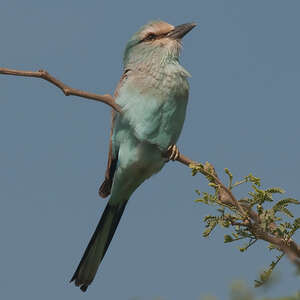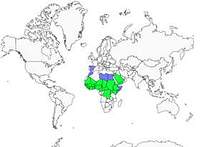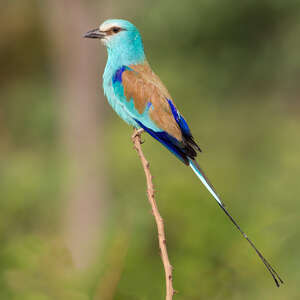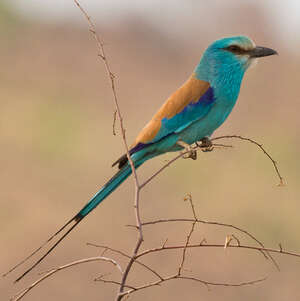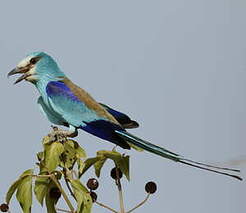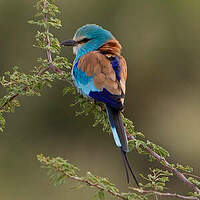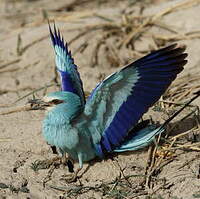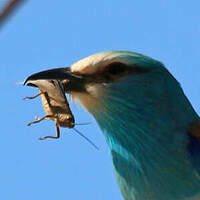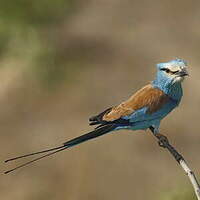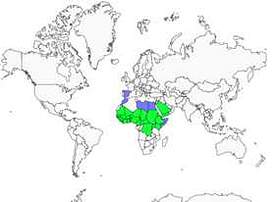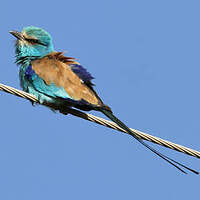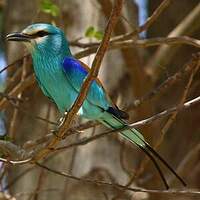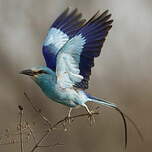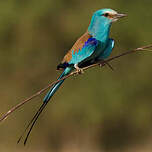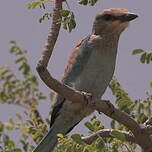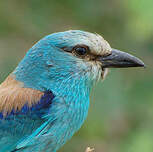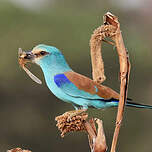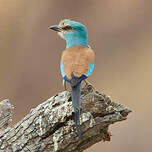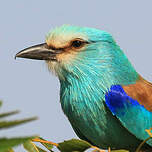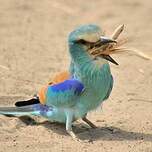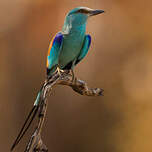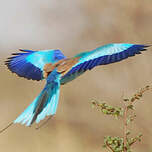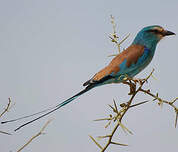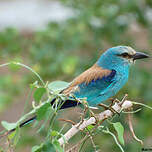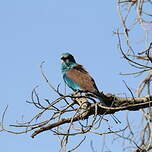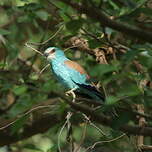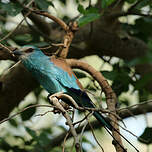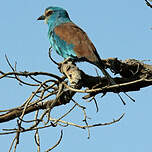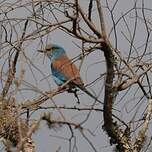Abyssinian Roller
Coracias abyssinicus - Rollier d'Abyssinie
Identification
The Abyssinian Roller, like all rollers, is probably one of the birds that every ornithologist or photographer loves to encounter, impossible to miss, its size ranges from 28 to 31 cm (42 cm with its two rectrices!). Its colorful plumage attracts the eye: the forehead and chin are white, the black eye is marked with a sharp black loral line that goes to a strong, also black beak. Its nape is blue-turquoise, the mantle and scapulae are brown, when the bird is in flight, three different shades of blue are distinctly seen on the top of the wings: the small and medium coverts are blue-marine, the large coverts and primary coverts are blue-turquoise, and finally the primaries become a very deep blue-marine. Still in flight, but seen from below, only two colors remain, blue-turquoise for the underwing and blue-marine for the primaries. The blue-turquoise chest is marked with faint white stripes and the belly becomes very light blue-azure. The tail is blue-marine, almost black in the center and blue-turquoise on the edges, and finally the Abyssinian Roller's last stroke of vanity: two large black rectrices which make the bird appear larger. The short tarses are pale gray.
Subspecific information monotypic species
Foreign names
- Rollier d'Abyssinie,
- Carraca abisinia,
- rolieiro-da-abissínia,
- Senegalracke,
- fecskefarkú szalakóta,
- Sahelscharrelaar,
- Ghiandaia marina abissina,
- savannblåkråka,
- Sahelråke,
- krakľa pláštiková,
- mandelík sahelský,
- Savanne-ellekrage,
- abessiniansininärhi,
- gaig blau d'Etiòpia,
- Álfahrani,
- kraska abisyńska,
- garastes zilvārna,
- abesinska zlatovranka,
- Абиссинская сизоворонка,
- オナガニシブッポウソウ,
- 蓝头佛法僧,
- savannblåkråka,
- 藍頭佛法僧,
Voice song and call
Habitat
Behaviour character trait
Dietfeeding habits
The Abyssinian Roller mainly feeds on all kinds of insects and caterpillars typically diving from a tree or other perch onto the insect, but is also capable of catching prey in flight. It can gather in groups of up to twenty individuals and follow herds of wild ruminants such as antelopes to take advantage of the insects flying nearby.
Reproduction nesting
Geographic range
Threats - protection
Sources of information
- IOC World Bird List (v15.1), Gill, F and D Donsker (Eds). 2025-12-07.
- Vol. 6 - Handbook of the Birds of the World, Josep del Hoyo-Andrew Elliott-Jordi Sargatal
- BirdLife International, BirdLife International
- Wikipédia, Wikipedia, The Free Encyclopedia
- Birds of Western Africa, Nick Borrow and Ron Demey
Other sources of interest
 Specification sheet created on
30/07/2023 by Anne et Gabriel Leboff
Specification sheet created on
30/07/2023 by Anne et Gabriel LeboffTranslation by AI Oiseaux.net
© 1996-2025 Oiseaux.net
- Accipitriformes
- Aegotheliformes
- Anseriformes
- Apodiformes
- Apterygiformes
- Bucerotiformes
- Caprimulgiformes
- Cariamiformes
- Casuariiformes
- Charadriiformes
- Ciconiiformes
- Coliiformes
- Columbiformes
- Coraciiformes
- Cuculiformes
- Eurypygiformes
- Falconiformes
- Galliformes
- Gaviiformes
- Gruiformes
- Leptosomiformes
- Mesitornithiformes
- Musophagiformes
- Nyctibiiformes
- Opisthocomiformes
- Otidiformes
- Passeriformes
- Pelecaniformes
- Phaethontiformes
- Phoenicopteriformes
- Piciformes
- Podargiformes
- Podicipediformes
- Procellariiformes
- Psittaciformes
- Pterocliformes
- Rheiformes
- Sphenisciformes
- Steatornithiformes
- Strigiformes
- Struthioniformes
- Suliformes
- Tinamiformes
- Trogoniformes

